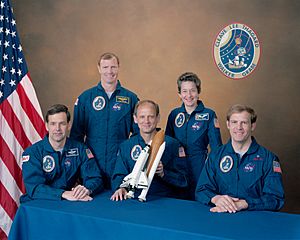Mary L. Cleave facts for kids
Quick facts for kids
Mary Louise Cleave
|
|
|---|---|
 |
|
| Born | February 5, 1947 Southampton, New York, U.S.
|
| Died | November 27, 2023 (aged 76) Annapolis, Maryland, U.S.
|
| Alma mater | |
| Occupation | Environmental Engineer Astronaut |
| Space career | |
| NASA Astronaut | |
|
Time in space
|
10d 22h 02m |
| Selection | 1980 NASA Group |
| Missions | STS-61-B, STS-30 |
|
Mission insignia
|
 |
| Retirement | 2007 |
Mary Louise Cleave (born February 5, 1947 – died November 27, 2023) was an amazing American engineer and NASA astronaut. She also helped lead NASA's science missions from 2005 to 2007.
Contents
Early Life and School
Mary Cleave was born in Southampton (town), New York in 1947. Her parents, Howard and Barbara Cleave, were both teachers. She grew up in Great Neck, New York, with her two sisters, Trudy and Barbara.
Mary finished high school in Great Neck, New York in 1965. She then went to Colorado State University, where she earned a degree in Biological Sciences in 1969. Later, she studied at Utah State University. There, she earned a master's degree in Microbial Ecology in 1975. In 1979, she received her doctorate in Civil and Environmental Engineering.
Working as an Engineer
Before becoming an astronaut, Mary Cleave worked as a researcher at Utah State University. From 1971 to 1980, she studied different things related to water and the environment.
Her work included looking at tiny plants called algae in desert soils. She also studied how to clean water using sand filters. Mary helped figure out how much water rivers needed to keep certain fish alive. She also looked at how pollution from oil shale could affect freshwater plants.
Becoming a NASA Astronaut
Mary Cleave was chosen to be a NASA astronaut in May 1980. She helped test the software for the Space Shuttle. She also worked as a CAPCOM, which means she was the person on Earth who talked to the astronauts in space during five Space Shuttle flights.
Mary Cleave flew into space twice. She spent a total of 10 days, 22 hours, and 2 minutes in space. During her missions, she orbited the Earth 172 times and traveled 3.94 million miles!
After her space flights, Mary left the Johnson Space Center in 1991. She joined NASA's Goddard Space Flight Center in Greenbelt, Maryland. There, she managed a project called SeaWiFS. This was a special sensor that watched the color of the ocean to monitor plants around the world.
Later, Mary Cleave became a leader at NASA Headquarters in Washington, D.C.. She was the Associate Administrator for the Science Mission Directorate. This meant she helped guide all of NASA's science missions. She left this important role in April 2007.
Space Missions
STS-61-B on Space Shuttle Atlantis
Mary Cleave's first space mission was STS-61-B on the Space Shuttle Atlantis. It launched at night on November 26, 1985, from the Kennedy Space Center in Florida. The mission lasted about 7 days.
During this flight, the crew launched three communication satellites. They also did two spacewalks to practice building things for a space station. They worked on experiments about how liquids move in space and how to grow crystals. This mission carried the heaviest cargo ever taken to orbit by the Space Shuttle at that time.
STS-30 on Space Shuttle Atlantis
Her second mission was STS-30 on the Space Shuttle Atlantis. This four-day mission launched on May 4, 1989.
The most important part of this mission was deploying the Magellan spacecraft. This was the first U.S. planetary science mission launched from the Shuttle. Magellan traveled to Venus and used radar to map over 95% of its surface. This mission gave scientists a lot of valuable information about Venus's atmosphere and magnetic field. The crew also worked on other experiments, like studying crystal growth and electrical storms on Earth.
Later Life and Legacy
Mary Cleave passed away on November 27, 2023, at the age of 76.
In 1995, Mary Cleave was honored on a postal stamp in Azerbaijan. This stamp was part of a series celebrating the 25th anniversary of the first moon landing.
In 2009, Mary Cleave gave a special talk at Georgetown University. She shared stories about her education and career as an astronaut. She even showed a film from her 1985 Space Shuttle mission.
Organizations Mary Cleave Belonged To
- Society for Professional Engineers
- Association of Space Explorers
- Women in Aerospace
- Tri Beta, Beta Beta Beta
- Sigma Xi
- Tau Beta Pi
See also
 In Spanish: Mary L. Cleave para niños
In Spanish: Mary L. Cleave para niños





